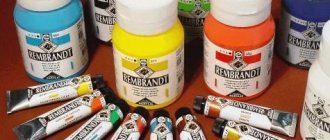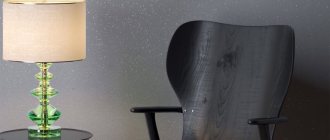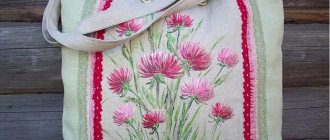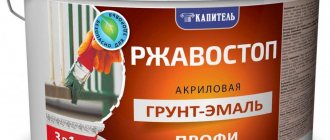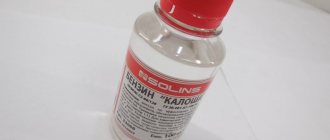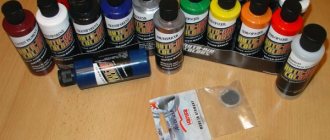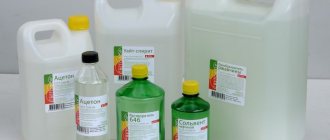Today, painting is quite affordable and one of the most favorite pastimes for a child, but several generations ago not everyone could afford this activity. But in the variety of artistic materials there is one nuance that a beginning artist must take into account.
It lies in the fact that it is quite difficult to choose paints suitable for specific purposes and tasks, since their different types differ not only in their physical properties, but also in the technique of application.
Acrylic is a universal material used in construction and painting. It dries quickly and adheres to almost any surface.
Acrylic paints are distinguished by their bright visual effects, richness and variety, which is why they are so in demand by artists with extensive experience and beginners.
They are absolutely harmless and can be used by animators during children's public events, competitions and master classes. But acrylic paints, like other art materials, have their own characteristics. To choose the right paint, you need to know its composition, properties, and also know the limits of applicability in different techniques.
Composition of acrylic paints
Any paint is a substance with a complex chemical composition. It contains components such as a coloring pigment, as well as various modifiers and, of course, a base.
Modifiers are added to paint to ensure that the material adheres well to different surfaces.
For example, not every paint can be used to paint on glass, iron or wood. In addition, additional components are introduced into the composition, making the paint layer after drying more plastic and resistant to external influences.
Acrylic paints are in demand among many experienced artists. Even those who do not delve into the details of the composition of the material know that acrylic is superior to oil and watercolor in many respects.
The drawing turns out elastic, which means that it is possible to roll the canvas. The paint on it is firmly fixed and does not crack. Also, acrylic is not afraid of temperature changes. It is resistant to low or high humidity.
The reason for the different characteristics of different types of paint lies in their composition.
The basis of acrylic paints are resins - polyacrylates. Their copolymers act as film formers.
The technology of using resins for the production of safe and high-quality paints was mastered relatively recently. It is polyacrylate that makes acrylic paint special. First of all, acrylic-based dyes have a very wide range of applications.
The artist gets the opportunity to draw on any surface, which is an undoubted advantage in creativity. Most handmade products are decorated with just such paints.
Finish coating
Sometimes, after the material has been applied in two layers, it is necessary to go over the outside of the material with a roller one more time, but this is optional.
If, after properly performing the preparatory work and painting the wall, you see an even and smooth exterior, the third coat of paint will be unnecessary.
Additionally, we recommend applying varnish to the painted surface, especially for metallic exteriors, to add shine. Typically, two balls of varnish are used.
How does paint dry?
The color of the paint depends on the pigment present in it. These are tiny granules that do not dissolve in water. A variety of substances are used as pigments, so they are divided into synthetic, natural, organic and inorganic.
The pigment itself does not adhere to the treated surface or practically does not adhere.
The granules are held in place thanks to a binder, that is, an acrylic polymer. When dissolved in water, this polymer forms a fine emulsion.
The paint dries after moisture leaves the emulsion through evaporation and absorption. A transparent polymer film remains on the surface, within which the pigment granules are “trapped”. In more detail, paint drying can be represented as a series of successive stages.
- Stage 1. Initially, as already mentioned, acrylic paint, regardless of the release form, is a mixture of pigment granules, water and acrylic emulsion. Water keeps the emulsion in its “raw” form and prevents the polymer particles from approaching each other, that is, it prevents the polymerization reaction from starting.
- Stage 2. The water from the emulsion begins to evaporate as soon as the paint begins to be exposed to the atmosphere. Moisture is partially absorbed into the base, so the drying speed of acrylic paint depends on the type of base. Acrylic particles approach each other and begin to interact (the polymerization reaction begins).
- Stage 3. After polymerization, acrylic turns into a stable polymer with the correct chemical structure. The pigment particles trapped inside the hardened resin are firmly held in place. As a result, a durable film of bright and rich paint is formed, which does not crack or fade over time. The hardening time is enough for the artist to correct all possible mistakes through multi-layer paint application. Thus, when painting with acrylic, there is no need to be afraid of ruining the work.
Painting walls
Painting walls with acrylic paint is a task that does not require extensive professional training. You will need the simplest tools:
- brushes,
- paint roller,
- paint tray,
- masking tape.
If the farm has a spray gun, you can also use it. It is not necessary to purchase this device specifically for interior work.
Use adhesive paper tape to cover baseboards, door jambs, slopes, and joints with the ceiling. The finished water emulsion or diluted acrylic dispersion is thoroughly mixed with a construction mixer or drill with an appropriate attachment.
The paint is poured into a tray, and all “inconvenient” places are painted with a brush: corners, joints, areas behind pipes, around switches and sockets.
The coat of the roller is impregnated with the coloring composition, the excess is removed and painting begins from the top or from the middle, making movements in the vertical direction and down alternately or in a w-shape (see video). In this way, paint the entire surface.
After the first layer has dried completely, you can apply the second. Usually this is quite enough to obtain an even tone.
Characteristics of acrylic paints
Acrylic paints can safely be called unique, since they have some properties that are not typical for other analogues. It has already been said that the material is suitable for any surface. This significantly expands the scope of its application. The paint is water-based.
Thus, during its production it is possible to obtain a dye of any consistency and viscosity. In addition, the evaporation of water causes the dye to harden.
As long as the water from the dye has not evaporated, acrylic paint remains liquid and is easily washed off with ordinary water. But after the moisture evaporates, polymerization of the acrylic occurs. It covers with a durable film that does not even interact with solvents. A layer of hardened paint is securely attached to the canvas and does not allow moisture to pass through.
The pigment in paint is only one of the components. Acrylic is a polymer that is also used by pedicurists for nail extensions. High speed of hardening and polymerization is a distinctive feature of the resin. Acrylic itself is transparent, so the presence of pigment in the paint is mandatory.
But the main feature is that during polymerization the resin does not affect the color shade in any way. The artist can be sure that the entire color palette will retain its original appearance after drying.
By the characteristics of acrylic paints we mean not so much technical parameters, since they are not understandable or interesting to everyone, but the main properties in which the materials are different or similar to analogues.
Moisture resistance allows the use of acrylic in the decoration of plumbing fixtures, as well as in the construction industry associated with high humidity. As for painting, here too this property plays a certain benefit.
The picture, painted with acrylic paints, is not afraid of water and other moisture. If a child decides to show his creativity not on paper, but on a special tablet, then his drawing will delight the eyes of his parents for a long time.
Acrylic hardens fairly quickly. The polymerization time of the resin is about two hours. This factor is taken into account both in painting and in everyday life. For any artist, it is important that the painting becomes transportable as quickly as possible. Considering that acrylic paints adhere well to any surface, they open up a wide space for experimentation.
There are certain features in the composition of the paint. The dye itself is added in the form of a pigment. It does not enter into a chemical reaction.
This means that it is possible to experiment with color.
First, the artist can create a preferred viscosity by adding the desired amount of water to the polymer. Secondly, adding additional color will not affect the physical properties of the paint itself. There is even an optical dye added to acrylic that glows in the dark. All that remains is to choose the appropriate color scheme.
Acrylic paints are capable of creating a palette, as they are easily mixed with each other. Those painters who are well versed in the theory of color production can save significantly by mixing their own shades on a tablet, rather than buying certain colors in a store.
The paint dries quickly, but not instantly.
Thus, after mixing the paint, you can continue experimenting for some time. According to most painters, the polymerization time of the resin is optimal. If desired, you can wait until one layer has set before applying subsequent layers of paint.
Acrylic paints are sold in jars or tubes. Paints in tubes are thicker. Their consistency resembles sour cream or butter. Since it is much easier to obtain thinner paint by adding water than to increase its viscosity, paints in tubes are in great demand.
Liquid paints are good in cases where it is necessary to form layers on a large surface, that is, for large-format work. Tube sizes may vary. The optimal volume is about 60 ml. Small tubes are convenient to take with you to the open air. Liquid paint cans are also available in a wide range of capacities.
For children, they usually buy jars of 55 g, but there are containers of 1 and 4.5 liters. Liquid paint can be further diluted with a special thinner or plain water, but this will require another container.
It is important to close the container tightly after work so that the water does not evaporate and the acrylic does not dry out.
It is necessary to remember the adhesive properties of the resin, so it is recommended to carefully clean the neck of the jar or tube so that you do not encounter problems when opening it again.
Thinning paints
The pigment of acrylic paints is small particles that are found in the binder component. The plastic mass in its raw form resembles milk, and after hardening it becomes transparent.
As long as the acrylic has not undergone a polymerization reaction, it is highly soluble in water. Water is used not only for dilution. Use it to wash the palette and brushes after finishing work. But acrylic paints, unlike other types of paints, become insoluble after drying. On the one hand, this is a significant disadvantage, since it is impossible to wash off dried paints.
However, most artists consider this quality as an undeniable advantage.
Layers of paint do not allow water to pass through, and the finished work is not susceptible to exposure to moisture. In addition, new layers can be applied over the dried layer of paint. If you wash your brushes well after each job, they will last a long time. If you are only careless about cleaning your brushes a couple of times, they will immediately become damaged. Particles of paint get clogged between the hairs of the bun, as a result of which the bun loses its former shape.
Not only water can be used as a diluent. Most acrylic paint manufacturers offer their own liquids that change the consistency of the polymer.
The so-called glossy and matte thinners deserve special attention.
Gloss thinner improves the covering properties of the paint. After hardening, a characteristic shine forms on the surface. Matte thinners, on the contrary, create matte surfaces.
Story
Acrylic paints are considered a fairly modern material, as they were first produced in Germany in the late 20s of the last century. The history of the invention of acrylic paints has several stages.
First, oil nitrocelluloses were obtained. They are considered the first synthetic paints. In New York, such paints were used in the automobile industry and in construction.
At the next stage, polyvinyl acetate was obtained, which contained alkyd masonry for buildings.
The ability to work with resins, as well as the ability to dilute them with organic solvents, became the starting point for the invention of acrylic paints.
The first paints were released in 1947 under the Magna brand. They were polyacrylic dissolved with turpentine. Water-soluble emulsions appeared only a few years later.
This was a breakthrough of sorts. The paint, which was distinguished by a high degree of brightness and also did not require a complex solvent, gained extraordinary popularity. It spread with great speed, so artists from different countries soon began to be interested in the possibilities of new paints.
The technique of working with acrylic has become almost the main one in modern painting since the mid-20th century. World-famous pioneers were such artists as Mark Rothko, Alan Charlton, Andy Warhol, Bridget Riley, Richard Estes and David Hockney.
Types of acrylic paints
Acrylic paints have the same base chemical composition. They differ from each other only in pigment and solvents. The classification by color composition is the most popular, so this is what should be considered.
- Matte paints. After drying, they form a dense layer, characterized by its low transparency. As a result, the paint lacks shine.
- Glossy paints are the complete opposite of matte paints. After polymerization, a transparent layer of resin is formed on the surface, in which pigment particles are embedded. The gloss is quite stable and does not disappear over time. Depending on the paint model, the surface can be perfectly smooth or slightly rough.
- Fluorescent paints have a characteristic glow after exposure to ultraviolet light. In addition to pigment, special components are added to the paint. They emit light in the green-blue range of the spectrum.
- Pearlescent paints are capable of refracting light. As a result, an original optical phenomenon is formed, which is similar to a three-dimensional picture. Pearlescent paints can have different shades. In them, the presence of the effect also depends on the added component.
- Metallic paints are distinguished by the presence of a peculiar shine. Metallic is in demand in decorative painting, but in traditional painting there are also paints that have a metallic sheen.
In an alternative classification, you can find heavy or concentrated acrylic paints. These are paints for painting that contain a lot of coloring pigment. Heavy paints have high viscosity and, as a result, high texture. Usually these paints are worked with a palette knife.
Adding water to paint will reduce its viscosity.
But not every novice artist knows how to increase viscosity. It turns out there are special pigment paints or gel media. They are added to the base dye to change the viscosity (both increase and decrease), as well as to change the transparency of the paint.
Student paints are a separate group. As the name suggests, this type of acrylic is most often used in art schools and is also popular among beginning students.
They are not safer, since any acrylic paints can boast the absence of components harmful to humans.
Student paints use cheaper pigment, and the palette has fewer colors. As a result of such savings, it is possible to significantly reduce the cost of the material.
Features of working with acrylic
Beginning artists approach working with acrylic paints with a certain caution, having heard a lot about the features of this material. Indeed, certain knowledge and skills will be needed.
The main difficulty that you will have to face is the irreversible and fairly rapid drying of the paint and the hardening of the polymer.
If you lack experience, you can waste valuable time and miss the opportunity to correct defects in strokes.
In this regard, you should be guided by basic techniques and recommendations from professional artists.
- It is recommended to begin to understand the practice of working with acrylic paints using the “wet on” technique. This technique is no different from the technique of working with watercolors. The paper and the brush itself are pre-wetted.
- The dry writing technique requires the presence of at least two brushes. The first brush is used to apply the main stroke. The second brush should be clean and damp. It is designed to adjust and correct the stroke.
- Acrylic paints allow for double brush strokes. This is a unique technique in which two colors of paint are applied to the brush at once. It is mainly used in artistic painting.
- The glaze technique when using acrylic turns out to be very successful. The technique itself consists in the fact that the image is formed layer by layer. Since acrylic film does not allow moisture to pass through after drying, this quality allows you to form a second and even third layer without mixing shades.
- Another technique that is suitable for acrylic is impasto. It is usually found in impasto oil painting. With a sufficiently high viscosity of acrylic paint, you can make textured and relief strokes. Acrylic in tubes is very suitable for working with a palette knife. It is believed that the impasto technique is the opposite of glaze.
Acrylic allows you to work with a spray gun, but the paint must be diluted with water.
Water is also used when the artist needs a lot of time to make corrections and wants to slow down the drying process.
If the paint on the palette has not completely dried, it can be “revitalized” by adding water. It is important to adhere to the following principles:
- Only distilled water should be taken;
- If water is drawn from the tap, then it must stand for 24 hours before use;
- The paint is diluted in a clean container.
The proportions of paint and water depend on the chosen technique and the consistency of the starting material.
For example, for glazing the water/paint ratio is 5 to 1, and the final layer is formed with a composition of 1 to 2.
A set of 8 – 10 colors of acrylic paint is quite suitable for a full-fledged work. You can get a dozen additional combinations from white, black, red, yellow and blue.
Color spectrum
The advantage of acrylic paints is their varied color range. At the same time, you can create a shade yourself if you add the selected color to a white base. The base is distinguished by the degree of whiteness:
- super white;
- white;
- milky white.
The base coat used for tinting is considered to be a beige base. When mixed with tinting paste, it gives calm, even tones, which are successfully used for interior decoration.
Reference! In addition to classic colors, acrylic compositions are presented in pearlescent, golden or silver tones.
Tools and materials
The first thing you need to do is make sure that the palette contains the right shades. If you have no experience in mixing paints or doubt that you will be able to get the color right, then you can use ready-made palettes, since acrylic paints are sold in a wide range, and you will probably find a tube of paint of a suitable color.
Beginning artists are recommended to practice their skills in obtaining color shades using primitive children's coloring books.
You can purchase a standard set of paints from basic colors and start mixing them in pairs. You need to start practicing on small formats. Only after understanding the theory of color combinations can you begin format work. Regardless of your experience and chosen technique, it is important to remember one rule - acrylic paints should not be left open.
Absolutely any brushes are suitable for working with acrylic paints. You can try your hand and evaluate the results of working with natural and synthetic brushes.
Acrylic in tubes is more convenient to use with plastic brushes, as it is thicker.
Paints diluted in water to a liquid state require a softer pile (protein or columns).
If you have chosen acrylic paints as the main material, it means that you are ready to experiment with texture. For this you will need a palette knife.
You can start with a regular diamond-shaped spatula, gradually developing the technique of applying strokes to the canvas.
Water should always be on hand, especially if you have chosen the “wet” painting technique. A spray bottle is suitable for wetting the canvas, but you also need to prepare a regular bottle of water.
An experienced artist always has a palette in his arsenal, that is, a tablet on which he prepares paints. If you don’t have such a tablet yet, you can use regular plastic disposable plates. The two-paper method will help retain moisture in the paint. The first paper is laid on the palette.
It must be fibrous to absorb moisture.
Ink is applied to this paper. The top of the paint is covered with parchment paper. Moisture from the bottom layer gradually penetrates the paint, preventing it from drying.
The acrylic paint thinner can simultaneously function as a retarder. By adding thinner to the paint, the artist gets a few minutes of extra time to work out the details of the drawing, shade the paint, or make corrections.
It is important to choose the right thinner for a particular type of paint, and for this you need to study the instructions.
There is a list of secondary materials that may be needed during the work process, but are not required.
These include:
- Water in a large container for washing the palette and brushes;
- Paper towels or napkins;
- Fine-grained sandpaper;
- Pencils, felt-tip pens or markers;
- Glue;
- Spray gun or airbrush;
- The basis.
Scope of application
Due to the high technical and operational properties, the unlimited scope of application of acrylic paints is not surprising. They can be used on almost all types of bases, be it wood, concrete, stone or metal, with the exception of some types of plasterboards, which greatly simplifies the choice of materials when carrying out finishing or repair work. In the line of any manufacturer there is always paint for interior and exterior work in a wide range of colors, therefore, there will be the same quality of the painted surface and matching shades during transitions.
When choosing, it is worth considering that there are universal paints in terms of bases, but within the group they usually differ in the specific application - for walls, ceilings and floors. This is due to a practical component - these zones have different operating conditions, and they look different due to the different angle of incidence of light. And the application technique is different, which determines the consistency and composition of the additives.
The popularity of acrylic paints is also explained by the atypical color range - while standard floor enamels are overwhelmingly brown, acrylic ones can be of any color.
Vlademir FORUMHOUSE Member
My wife wants floors at home that are not the color of traditional floor paint, but light, with a brownish tint, that is, as light as possible. Nearby stores offer acrylic flooring; the manufacturer's assortment includes a light color. Does anyone have experience?
Eat.
Nika19 Member of FORUMHOUSE
We painted with water-soluble acrylic, the color was a straw. It turned out to be light-light yellow, a nice shade, I also love light floors.
Useful tips
- Water is added to paint to control its transparency. But it is important to understand that if the paint contains more than 20% water, then even a completely dry layer will not be as durable and may peel off from the surface.
- In the technique of painting with acrylic paints, work usually begins with drawing large details. Small fragments are completed while large areas are drying.
- Do not rush to use a washed brush. First, blot it with a napkin or paper towel.
- Try to choose acrylic-based thinners.
- To distribute the acrylic paint evenly on the canvas, work with the tip of the brush.
- If you need to get a clear border between the colors, you can use adhesive tape or tape and paste the strip onto a pre-dried area.
Do not neglect the advice of experienced painters, as this will eliminate the need to learn the basics of the technique by trial and error.
Surface preparation
The essence of primary surface preparation is to thoroughly remove previous traces of repair.
It is important to completely remove all remnants of wallpaper, paint, and plaster so that further painting can be done efficiently. After removing all residues, the surface must be degreased, especially if there are traces of fungus and dampness.
If after cleaning there are pits, cracks or other minor defects, it is necessary to plaster and cover them, the quality of which determines the final result.





